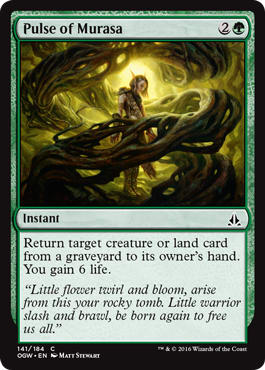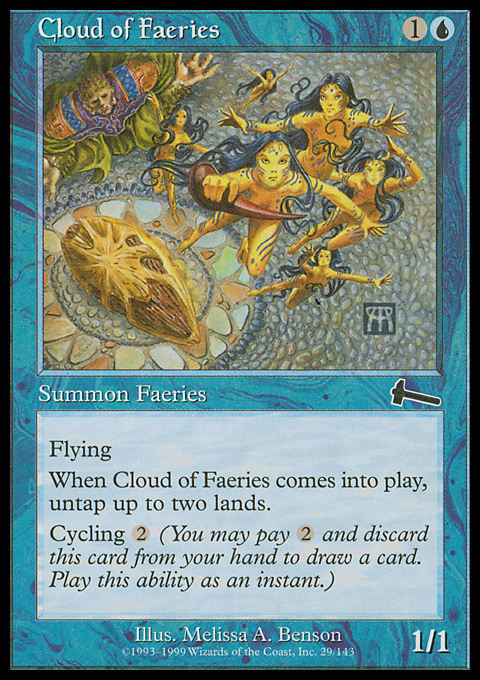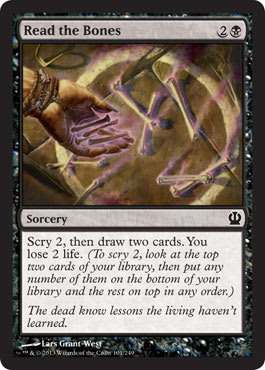Today, I am going to talk about Pulse of Murasa in Pauper.
But first, maybe a little bit about the format.
Pauper is all-commons Constructed Magic. It is played mostly on Magic Online, where any card printed as a common digitally is legal. This includes cards from Vintage Masters like Battle Screech. However, some cards that are common in the paper world are not similarly rare online—see Hymn to Tourach. The discrepancy has created a small divide between Paper and Online Pauper, but many paper tournaments have begun adopting the online card list.
Why?
Pauper Online receives more attention from Wizards of the Coast, and members of R&D have specifically said that reprint sets are a perfect place to grant Pauper access to cards that were once uncommon or rare.
Online Pauper is largely played in Leagues. These are competitive tournaments in which a person enters a deck and then plays five matches. They do not have to be played sequentially. At the end a run (five matches), that player can then switch decks and play again. Prizes are awarded based upon record, and every day, ten randomly selected undefeated decks are posted to the Mothership. It is from there that we can glean an understanding of the metagame.
The metagame data is far from perfect. The league hovers above seven hundred players, and having ten unbeaten lists per day is nice, but it may not be representative of what is actually being played. It also benefits decks that can go on a streak and put together a string of good matches. All this being said, these data also provide a decent gauge of what someone may face if he or she decides to play in the Pauper League.
Pauper maintains a relatively small ban list for a nonrotating format. The list is Cloud of Faeries, Cloudpost, Cranial Plating, Grapeshot, Empty the Warrens, Frantic Search, Invigorate, Temporal Fissure, and Treasure Cruise. Other than that, any card found on Magic Online with a black expansion symbol is perfectly legal.
That first card—Cloud of Faeries—is the most recent addition to the list. Removing the Urza’s Legacy standout from the format has shaken up the top tier. Formerly, a Delver of Secrets–powered blue deck ruled the roost. Using Delver to present an early clock, the deck would follow it up with Cloud of Faeries and leave back mana for Spellstutter Sprite or Counterspell. Such an opening would slam the door on many decks and make for quick painful games. Cloud of Faeries was also instrumental in the second best deck: a combo deck that used Nightscape Familiar, Mnemonic Wall, and Ghostly Flicker to generate an unbound number of Sage's Row Denizen triggers.
Don’t laugh; it worked.
So when the Oath of the Gatewatch ban list was released, Pauper lost a card in the interest of “color diversity.” The intervening weeks have seen many of the same decks perform well, but there has been some shifting in their relative power.
Affinity
The early winner has been Affinity. In Pauper, Affinity has access to all the artifact lands, Disciple of the Vault, and Atog. This gives the deck access to a combo fill when combined with either Fling or Temur Battle Rage. Failing that, Affinity can just play an undercosted beatdown game with Carapace Forger, Myr Enforcer, and Somber Hoverguard. Unlike its Modern counterpart, this deck does not need to make the decision between Thoughtcast and Galvanic Blast, as it can easily run both.
As of this writing, Affinity is the most popular undefeated deck at nearly 14% of the 5–0 metagame. Affinity is a strong contender, but it does have one glaring weakness: Gorilla Shaman. The Mox Monkey is common online and does a ton of work against artifact lands. While not universally adopted, the presence of Gorilla Shaman is enough to make me take pause before piloting Affinity. There is also copious hate in red, green, and white, giving many decks solid sideboard options. Despite this, Affinity succeeds because it can overwhelm an opponent before defenses have been established.
Affinity ? Pauper | Jakestiles, 5?0, Pauper League
- Creatures (20)
- 4 Atog
- 4 Carapace Forger
- 4 Somber Hoverguard
- 4 Frogmite
- 4 Myr Enforcer
- Spells (24)
- 2 Fling
- 4 Galvanic Blast
- 4 Thoughtcast
- 2 Prophetic Prism
- 4 Chromatic Star
- 4 Flayer Husk
- 4 Springleaf Drum
- Lands (16)
- 4 Ancient Den
- 4 Great Furnace
- 4 Seat of the Synod
- 4 Tree of Tales
- Sideboard (15)
- 4 Ancient Grudge
- 3 Electrickery
- 2 Journey to Nowhere
- 2 Armadillo Cloak
- 1 Hydroblast
- 3 Pyroblast
Mono-Black Control
The second most popular deck at the moment is Mono-Black Control. MBC has long been a part of the Pauper metagame, but it was the printing of Gray Merchant of Asphodel that pushed Swamps to the top of the charts. The deck has access to all the fantastic removal printed at common before the relatively recent trend of moving unconditional kill spells to higher rarities. MBC is able to leverage Chittering Rats and Phyrexian Rager to create a stream of card advantage while committing devotion to the board. Unearth helps to ensure that trades between 2/2s end up ever in your favor. Sign in Blood is among the better draw spells in the format and helps to keep the creatures and removal coming, while Gurmag Angler can pick up the pieces to present a rather impressive threat.
But really, this deck is all about Gray Merchant of Asphodel. At 4 toughness, it puts up a sizeable roadblock to aggressive decks. Its enter-the-battlefield trigger is another impediment to beatdown. Oubliette is a slightly better black Journey to Nowhere that does a great job of adding black mana symbols to the battlefield, but it also lets MBC keep Rancor (a key card in green beatdown) off the table. If it did not stay on the board, chances are MBC would find a different exile removal spell. Where Affinity uses its lands to turn on its synergy, MBC tries to do the same thing with its permanents. Liliana's Specter, Pestilence, and Cuombajj Witches all see some play, but the goal is the same: remaining hopeless devoted to Gray Merchant.
Mono-Black can be a bit on the slow side and struggles against decks with creatures that can sidestep their removal. Young Wolf and Safehold Elite are a nice solution to Chainer's Edict while Order of Leitbur can dodge Disfigure all day. A deck that can establish threats while keeping its life total high enough to stop Gray Merchant from doing its job has a shot. Being able to out-value the deck also goes a long way to victory.
Mono-Black Control ? Pauper | Chiere, 5?0, Pauper League
- Creatures (21)
- 1 Crypt Rats
- 2 Fume Spitter
- 2 Gray Merchant of Asphodel
- 2 Gurmag Angler
- 2 Liliana's Specter
- 4 Chittering Rats
- 4 Cuombajj Witches
- 4 Phyrexian Rager
- Spells (17)
- 4 Disfigure
- 3 Chainer's Edict
- 3 Unearth
- 4 Sign in Blood
- 3 Oubliette
- Lands (22)
- 17 Swamp
- 1 Bojuka Bog
- 4 Barren Moor
- Sideboard (15)
- 2 Gray Merchant of Asphodel
- 4 Choking Sands
- 4 Duress
- 1 Wrench Mind
- 1 Chainer's Edict
- 1 Death Denied
- 2 Nihil Spellbomb
Kuldotha Jeskai
The third most popular deck is Kuldotha Jeskai. A midrange control deck, Kuldotha Jeskai is an odd-looking number. It uses both Kor Skyfisher and Glint Hawk to bounce and recast Prophetic Prism and Ichor Wellspring to keep a constant flow of cards. With blue for Mulldrifter, Jeskai is exceptional at keeping the cards coming. It runs Journey to Nowhere for removal but supplements it with both Lightning Bolt and Galvanic Blast (powered by artifact lands). The normal game plan is to keep the board clear and gain life with the Khans of Tarkir gain lands and Lone Missionary until an air force can be established. After a few hits, Galvanic Blast and Lightning Bolt perform mop-up duty.
The deck earns its name from the few copies of Kuldotha Rebirth it runs as a way to draw more cards off Ichor Wellspring. The three tokens do good work clogging the ground and acting as fodder for Chainer's Edict. A value machine, Kuldotha Jeskai has picked up steam since Cloud of Faeries got the axe, and it shows no real sign of stopping.
Jeskai is a plodding deck. It will often set itself back on tempo for the sake of card advantage. A deck that can capitalize on speed and keep Jeskai on its back foot has a good chance of overwhelming its defenses. Jeskai also relies on a few small creatures to soften up a life total. Being able to keep 2/2 flyers at bay makes it harder for the burn spells to do their jobs.
Kuldotha Jeskai ? Pauper | Pietrosas, 5?0, Pauper League
- Creatures (12)
- 4 Glint Hawk
- 4 Kor Skyfisher
- 4 Mulldrifter
- Spells (26)
- 2 Dispel
- 4 Galvanic Blast
- 4 Lightning Bolt
- 2 Chain Lightning
- 3 Kuldotha Rebirth
- 1 Oblivion Ring
- 2 Journey to Nowhere
- 4 Ichor Wellspring
- 4 Prophetic Prism
- Lands (22)
- 1 Azorius Chancery
- 1 Boros Garrison
- 1 Izzet Boilerworks
- 1 Wind-Scarred Crag
- 2 Secluded Steppe
- 2 Tranquil Cove
- 3 Forgotten Cave
- 3 Swiftwater Cliffs
- 4 Ancient Den
- 4 Great Furnace
- Sideboard (15)
- 1 Journey to Nowhere
- 3 Celestial Flare
- 1 Negate
- 1 Kor Sanctifiers
- 1 Bojuka Bog
- 2 Electrickery
- 3 Lone Missionary
- 3 Pyroblast
So what does this tell us about the top of the Pauper standings? Protecting your life total matters as a defense against Galvanic Blast decks. There are also decks that thrive on killing creatures, meaning a card that can fight the attrition battle can do good work.
And this brings us back to Pulse of Murasa. A large portion of Pauper decks are either focused on quickly reducing a life total or on removing threats. Pulse of Murasa is able to fight both styles of decks on their respective axes. As a Raise Dead that buys a turn of damage, it does quite a bit of work.
But what sort of deck wants to run this card? I have had some success with a B/G midrange strategy that tries to out-value the value decks. Read the Bones is an upgrade to Sign in Blood, but without access to Gray Merchant of Asphodel, the 2 life matters—remember those copies of Galvanic Blast. Pulse of Murasa makes it easier to pay the life while also recouping a potential Evolving Wilds or Terramorphic Expanse used to fix our mana. These two 3-mana cards seem to be best friends.
The result is a deck that is skewed toward the top end of the metagame. Shambling Shell was included to help combat Journey to Nowhere and other removal while simultaneously providing potential fuel for Pulse of Murasa. Putrid Leech is a two-way all-star, as it can play shutdown defense early and start turning sideways once the time is right to be aggressive. It also happens to be able to handle Kor Skyfisher and Gray Merchant of Asphodel in single combat. Scion Summoner adds 3 power to the table across two bodies, helping to soak up Edicts.
While the deck started with two copies of Gurmag Angler, I’ve switched to a single Twisted Abomination. I am not sure if this is correct, but the ability to cycle for a Swamp early and Murasa back a 5/3 late is attractive. Warren Pilferers get the nod due to the ability to “draw” a card while also being able to crash through a Kor Skyfisher. The single Wickerbough Elder is there since so many decks run a legal target.
Yavimaya Elder is an additional Read the Bones that does not cost any life. It also plays well with the main-decked Sylvok Lifestaff, which is there to shore up aggressive matchups. Finally, the lone Moldervine Cloak is there to turn our glue—Elvish Visionary—into a true threat.
Murasa Rock ? Pauper | Alex Ullman
- Creatures (18)
- 1 Twisted Abomination
- 1 Warren Pilferers
- 1 Wickerbough Elder
- 1 Yavimaya Elder
- 2 Crypt Rats
- 2 Scion Summoner
- 2 Shambling Shell
- 4 Elvish Visionary
- 4 Putrid Leech
- Spells (18)
- 2 Doom Blade
- 2 Echoing Decay
- 2 Tragic Slip
- 2 Read the Bones
- 3 Chainer's Edict
- 3 Pulse of Murasa
- 1 Moldervine Cloak
- 2 Dead Weight
- 1 Sylvok Lifestaff
- Lands (24)
- 6 Forest
- 7 Swamp
- 1 Bojuka Bog
- 1 Tranquil Thicket
- 2 Golgari Rot Farm
- 3 Evolving Wilds
- 4 Jungle Hollow
- Sideboard (15)
- 1 Dead Weight
- 3 Duress
- 1 Chainer's Edict
- 1 Doom Blade
- 1 Grim Harvest
- 1 Read the Bones
- 3 Caustic Caterpillar
- 2 Moment's Peace
- 1 Pulse of Murasa
- 1 Claws of Wirewood
Is this the best home for Pulse of Murasa in Pauper? I’m doubtful, but it’s a great start. With so many cards able to turn cards over into the graveyard, Pulse starts to approach tutor status with a 6-life buffer. Because Regrowing a creature is great, but staying alive long enough to cast it is what counts.
There’s more to Pauper, of course. Decks are posted every day on the Magic Online decklist page. In addition to the archetypes discussed today, Delver continues to do well in both a mono-blue and a U/B variety with Thought Scour and Gurmag Angler. Goblins, Burn, and a U/R Nivix Cyclops/Temur Battle Rage deck also act as a limiting factor for how long one can survive. At the control end of the spectrum, Mystical Teachings and Tron decks both thrive by trying to invalidate anything the opponent can muster.
There are a few main repositories for Pauper discussion. The first is on Twitter through the hashtag #MTGPauper. A Pauper subreddit exists as the main discussion board. Additionally, I maintain a page where I compile statistics on the format.
Pauper is just starting to pick up steam again. The format has a decent amount of unexplored space for decks, and it doesn’t take much to put together a deck to start slingin’ commons. So what are you waiting for?

























